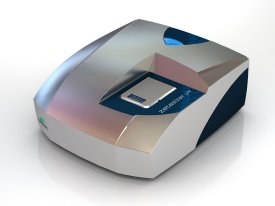Oct 10 2008
Malvern’s new Zetasizer µV is an advanced light scattering system specifically intended for the characterization of proteins and other biomolecules. This latest addition to Malvern’s highly successful Zetasizer family, is designed and optimised for maximum sensitivity and minimum sample volume. The Zetasizer µV is a dedicated system that supports improved understanding and management of a wide range of biomolecule applications, including: optimising sample and storage conditions; verifying the quaternary structure of protein complexes; identifying thermal characteristics; and assessing protein solubility and sample purity.
 The new Malvern Zetasizer µV for the characterization of proteins and other biomolecules.
The new Malvern Zetasizer µV for the characterization of proteins and other biomolecules.
The amount of protein available, particularly during early stages of discovery is often very limited, so the ability to measure very small quantities is critical. The Zetasizer µV requires just two microlitres of sample, allowing measurement of as little as 40 nanograms of BSA (bovine serum albumin) for example – an industry leading specification. Sample is recoverable, ensuring no loss of valuable material. The use of SOP’s (standard Operating procedures) means that the measurements proceed with no user input and are managed and supported by the proven software used throughout the Zetasizer range.
The Zetasizer µV employs both dynamic (DLS) and static light scattering (SLS). DLS determines the diffusion speed of proteins and nanoparticles in solution to give accurate measurement of size and size distribution. SLS enables determination of absolute molecular weight and 2nd virial coefficient, a parameter used to assess protein solubility and suitable conditions for crystallisation.
However, the real value of the Zetasizer µV lies in using the measured properties to help solve application problems. In bioprocessing, for example, it can be used to investigate the effects of changing environmental factors on the monomeric or oligomeric state of a protein. In drug target development, dynamic and static light scattering in combination can help in optimising crystallization conditions, speeding up the development process. In protein therapeutics, where the presence of aggregates can cause adverse effects, DLS provides an extremely sensitive method for aggregate detection, improving the success of a purification procedure or providing a tool for monitoring the early stages of instability.